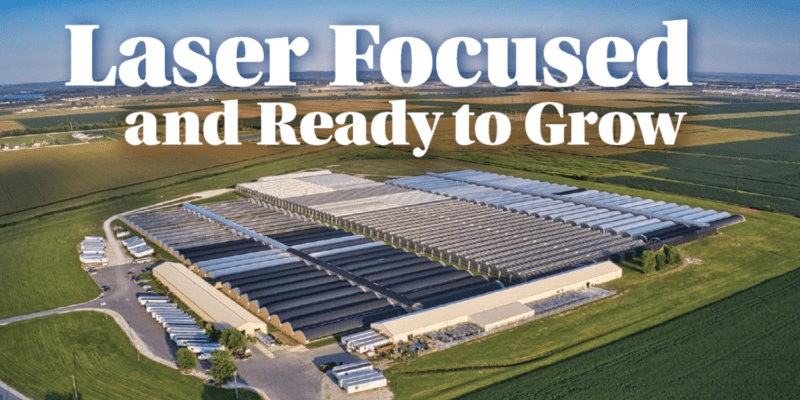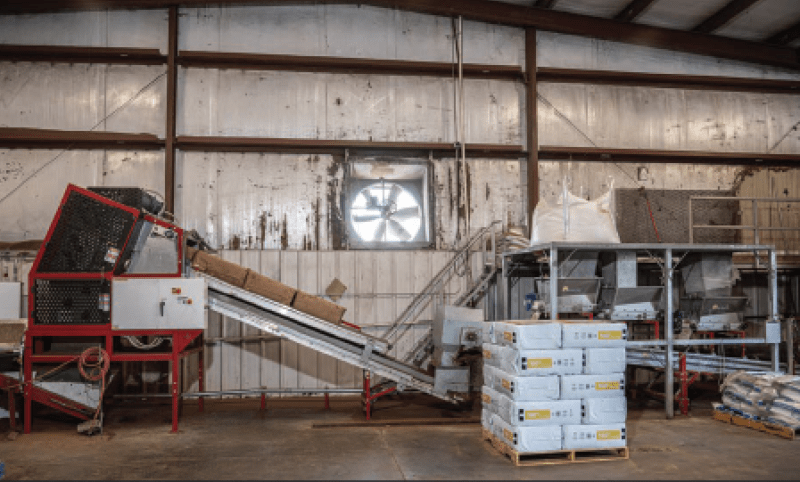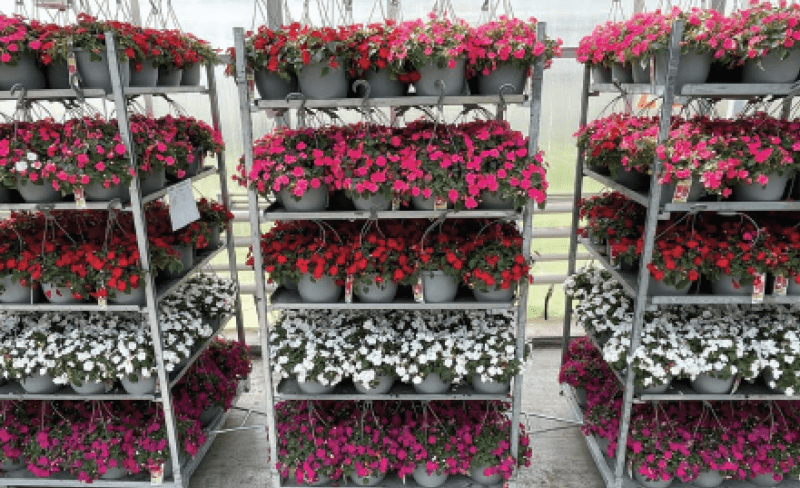
Cover Story — Laser Focused and Ready to Grow
Back in 2014, Dallas Johnson Greenhouses, based in Council Bluffs, Iowa, graced the cover of Big Grower and we offered a glimpse into their production in the cover story. The team at Dallas Johnson has always been dedicated to their craft and open to share what’s worked, what hasn’t and what’s in store for the future.
Seven years seems like a lifetime ago — in greenhouse years. A lot has changed, while so much has stayed the same. This month, we decided to circle back and catch up with our friends at Dallas Johnson to learn how they’re navigating a very tumultuous and unprecedented time in our industry and how they’ve maintained a positive outlook through it all.
One thing I observed in my first article seven years ago that still holds true today is Dallas Johnson Greenhouses’ laser focus. Focus on product quality, focus on customer service and focus on innovation. And it’s
that focus that will continue to lead them into all the unknowns of 2022
and beyond.
LABOR – A CURSE AND A BLESSING
Ask anyone in the industry what their biggest challenge is, and I’d besurprised if they didn’t respond with “labor.” From paying your staff to finding and keeping skilled workers to maintaining worker safety, it is all very overwhelming and taxing. But at the same time, creating and nurturing a successful team is incredibly rewarding. They are, after all, the key to a successful operation.

And Todd Johnson, CEO and president, knows this all too well. He boasts, “We have the best staff in the world. They make things happen that you don’t think can get done. They step up, up and beyond the call of duty.”
His praise doesn’t just end in the production house; it reflects all facets of the operation — from forecasting to customer service to replenishment to maintenance.
But putting together a successful and productive team does NOT come without its challenges. As a matter of fact, Todd says in late 2019 (pre-COVID), the Department of Homeland Security performed an audit on the business and they consequently lost a number of employees.
Luckily, “pre-COVID, we had already contracted to have 40 H-2A workers in. But once we had the audit, we knew we were going to lose people. We immediately tried to hire another 40 H-2A workers, and we were able to.”

While Johnson was able to recover the loss in workers, wages were significantly impacted. Todd says, “When we switched to H-2As, we had to
go by the adverse effect wage rate,” which at the time was $14.67 per hour.
Today, Todd says the prevailing wage has increased to $15.37, which he will gladly pay because — on the flip side of the situation — the Dallas Johnson Greenhouses team has never been stronger! With the addition of the H-2A workforce, Todd says the team has become even more effective and efficient. “They’re here strictly for one purpose, and that’s to work,” he says.
While the H-2A workers are only contracted for 10 months of the year, the majority of them have returned to continue working the
following season and plan to continue doing so for the time being.
COST EFFECTIVENESS
As the price of labor (along with supplies) continues to go up, Todd admits it will become impossible to remain sustainable without increasing pricing for their customers.
“Anybody in the industry this year is going to have no choice but to increase costs,” he says. “I don’t see how anybody can continue to operate at the same price as the status quo, because it is going to create a shortfall as far as profitability to where we don’t have any money to keep up our infrastructure.”
Justin Woods, vice president of operations, agrees and says his main objective going forward is to grow the business sustainably. “We need to be able to do regular maintenance, the regular things that need to be done every year,” he says. “All these increased expenses prevent us from re-covering houses, buying new trailers, getting more racks — all the random stuff that you really don’t think about.”
Many growers have been reluctant to increase their prices, especially because those increases will then trickle down at retail, and consumers will see a difference on the price tag. Will they pay an extra dollar or two for a plant? That is the question that has become impossible to answer.
Justin says, “Consumers are extremely price conscious; however I think there is enough wiggle room throughout our product line to increase costs and retails. Consumers are seeing everyday items increase; why would they expect it to be different for flowers at retail?”
He says the pandemic forced many new garden center consumers to take that leap of faith and buy plants not necessarily caring if they failed. “I totally believe that many people found that gardening and sprucing up their yards is very gratifying. Sales were stronger in ’21 than in ’20. I don’t see this trend slowing down with the housing market booming.”
PROVEN GENETICS
By now, we all know that the plant and gardening industry exploded last season as we gained millions of new gardeners. And going forward, the question continues to be, “How do we keep them?” At retail, there is a multitude of ways that plant sellers can get creative with marketing, promotions and merchandising.

At the grower level, though, there’s only so much you can do. The one thing in your control is product quality. If a consumer finds success and has good luck with a specific product, they will return. At least, that’s the goal.
“Part of being successful is using the right genetics and making sure [the consumer] has the opportunity to be successful without a lot of expertise,” says Todd.
That success begins in the greenhouse and works its way to the retailer. Todd says the plants need to be presentable at the store level. “Make sure that it looks good to start with, and then they have a fighting chance to maintain it. When you start off with a poor plant, it goes backwards really quick. Then they lose interest because they fail immediately.”
Early on, finding less expensive genetics was a common practice. But Todd says he has learned over the years that the genetics are the primary source of future garden success.” So, we pay the extra cost to make sure that the genetics meet the highest standards,” he says. “This has also increased costs a little bit, but on the back side, we have less loss, less shrink.”
Justin shares, “At the end of the day, I want to grow something good. Then it will sell at retail, and the retailer is calling back to order more.”
ADAPTING THROUGH SUPPLY CHAIN DISRUPTIONS
Demand has been high the past two seasons; there is no question about that. But no one could have predicted that we were on the verge of a global pandemic, let alone all the repercussions that go along with it. While the plant industry as a whole fared well, it did not come easy for plant producers.
The pandemic is far from over. “We’re still going through this crisis to a degree,” shares Todd. “The whole COVID hiccup is creating quite a shortfall in a lot of areas. Labor is one, and the other is the supply chain, which is completely flipped upside down.”
Procuring supplies has become a struggle at all levels of pretty much every industry. For growers, the one area that has seen the most disruption is plastics.
Justin says they are currently planting mums in whatever they can find because their pots have still not arrived. They are running into a similar situation with poinsettias.
Luckily, Dallas Johnson Greenhouses invested in AutoStix and Ellepot technology three years ago, which has been a lifesaver during this time. Justin says they plan to use AutoStix to plant poinsettia cuttings into Ellepots and let them root until the plastic arrives.
With mums, they used a similar strategy. “We waited 50-60 days to get our [mum containers]. So we were putting the cuttings into a quart or 5-inch pot. And when the 5-gallon planters showed up, we just took five of those 5-inch pots and plopped them into the 5-gallon container.”
PREPARING FOR 2022 AND BEYOND
The goal for Todd Johnson and the team at Dallas Johnson Greenhouses has remained the same over the years — to always focus on quality (the plants) and service (the staff). Even through one of the most challenging times in the history of the business, that focus has never wavered.
When the pandemic began and a bit of hysteria ensued across all industries, Todd is proud of the way he and his team handled the situation.
“Instead of just guessing and pulling back on production, we stayed on course. We didn’t change any of our planning,” he says. “We stayed with the forecast that we had put in place, and we kept pumping stuff out even though there was a lot of anxiety at the time. We stayed with the game plan, and I think that was the thing that brought us through in a positive light.”
Nearly two years later, the game plan has not shifted. Todd and Justin are both laser focused on strengthening the team at Dallas Johnson Greenhouses and ready to make additional investments when the time is right.
In a perfect world, Todd says he would add another 10 acres now to continue to meet customers’ demands. But he is waiting for the supply side to catch up and pricing pressure to go down. He says, “Before, it used to be that the labor issue was my big mitigating circumstance for expanding. Now it’s the supply side and cost pressures.”
One of Justin’s biggest goals within the last two or three years is building the team. He says many staff members are two to 10 years away from retirement. “That’s been my focus — trying to find people who already have that leadership skill set,” he says. “And we’ve actually had a few people step up into a management role after only being here for two seasons.”
He pridefully shares, “In the 14 years that I’ve been here, this is by far the strongest team that we’ve had.”
DALLAS JOHNSON GREENHOUSES AT A GLANCE
Established: 1985
Location: Council Bluffs, Iowa
Total growing space: 3.2 million square feet
Management team: Todd Johnson, president & CEO; Justin Woods, vice president-operations; Mark Philby, general manager of annuals; Harvey Lodge, general manager of perennials; Saul Quintana, assistant general manager; Steve Garvey, head grower
Number of employees: 100 full time (280 at peak season)
Customers: Big box retailers throughout Iowa, Nebraska, South Dakota, North Dakota, Wyoming, Colorado, Oklahoma, Kansas, Missouri, Illinois, Minnesota and Wisconsin
Product offering: Annuals, perennials, mums, poinsettias, edibles
Website: www.djgreenhouses.com


 Video Library
Video Library 




















